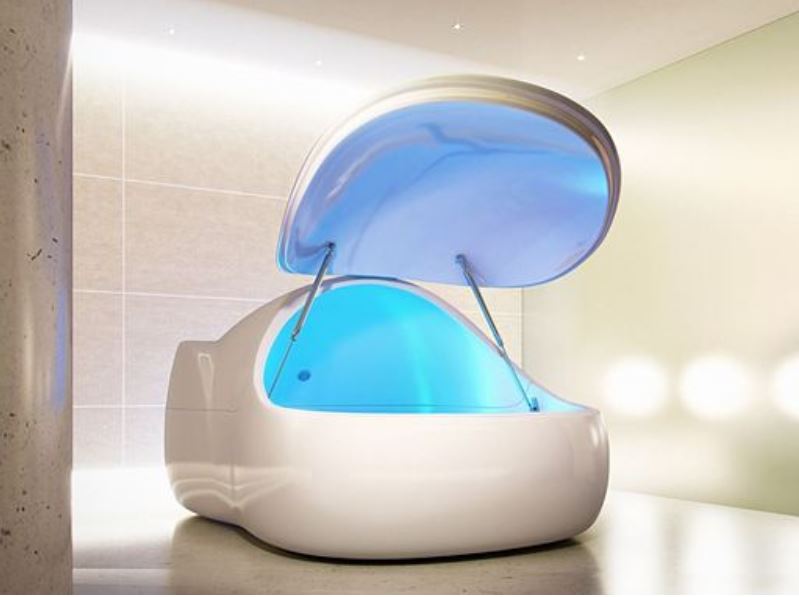
What is a sensory deprivation tank?
You’ve probably seen brochures advertising sensory deprivation tanks at your local spa and wellness center. They’re often referred to as isolation tanks or floatation therapy and it’s a form of restricted environmental stimulation therapy or R.E.S.T for short.
Sensory deprivation tanks are usually dark in color and completely soundproof. They’re also filled with salt water that’s usually the same temperature as normal body temperature to create a sensation of weightlessness and absolute sensory deprivation.
History
Sensory deprivation tanks were first invented and introduced by an American physician named Dr. John C. Lilly in 1954. Dr. Lilly’s intention with the tanks at the time was to use sensory deprivation as a means to understand the origins of consciousness.
However, things got weird over the course of the next few decades as Dr. Lilly started mixing in other unconventional methods like psychedelic treatment and hallucinogens. His floatation tanks continued to garner interest nonetheless, and the first commercial floatation tanks were released in the early 70’s.
Since then, a great deal of scientific research has been conducted to understand the effect and health benefits of sensory deprivation tanks. We now have scientific evidence to prove that floatation therapy offers a wide variety of health effects from muscle relaxation to pain relief and stress reduction.
To start with, the water in a sensory deprivation tank is filled with magnesium sulfate, also known as Epsom salt, and is the same temperature as your skin. This is what gives it exceptional buoyancy so that you’re able to float effortlessly.
As the name implies, the point of being in a sensory deprivation tank is to completely eliminate any and all stimulation, which is why you must be nude when you enter it. In addition to your clothes you’re stripped of all sight, sound, gravity and all your other senses. As soon as that tank lid closes, you’ll be immersed in a world of complete darkness and silence. For many, this leads to instant relaxation of the body and mind, which can help you to tap into your inner creativity.
In fact, research shows that floating in a sensory deprivation tank can boost creativity, intuition and even imagination. Here are some of the other proven health benefits of sensory deprivation tanks:
-
Increased focus and concentration:
Sensory deprivation therapy has been shown to improve focus and concentration. During early research stages it was discovered that sensory deprivation can lead to increased concentration levels while promoting clearer thinking. That’s why many people use sensory deprivation therapy to improve their performance in life, at work and at school.
-
Improves physical ability:
Many athletes turn to sensory deprivation therapy as a way to improve athletic performance. According to a study of 24 college athletes floatation therapy can decrease blood lactate levels after strenuous physical exercise.
Yet another study involving 60 elite athletes discovered that sensory deprivation tanks can also improve post-training psychological recovery.
-
Alleviates stress and anxiety:
A 2018 study with 50 participants that suffered from stress and anxiety showed that a one-hour session of floatation REST can significantly reduce stress and anxiety while simultaneously boosting mood.
Another study featuring 46 anxiety disorder patients found that sensory deprivation therapy can alleviate irritability, anxiety, depression, fatigue and even sleep deprivation.
-
Eases pain:
Several studies have confirmed that sensory deprivation can significantly alleviate chronic pain. It’s also helpful in treating muscle tension, stiff neck, stress related pain, headaches and migraines.
-
Improves cardiovascular health:
According to research, sensory deprivation may also play a role in improving cardiovascular health due to its ability to induce relaxation and improve sleep. That’s because lack of sleep and chronic stress have been shown to contribute to cardiovascular disease and high blood pressure, both of which can be alleviated by a floatation R.E.S.T session.
-
Boost mood:
There’s no shortage of pundits who say that they feel lighter, happier and more contented after a sensory deprivation session. This leads to feelings of euphoria, optimism and overall well-being. There have even been accounts of people who say they feel particularly peaceful and even spiritually edified after a sensory deprivation session.
As you can see, this is a healing modality with great potential to alleviate many of the symptoms that we experience today as a result of busy lifestyles and unhealthy habits.
